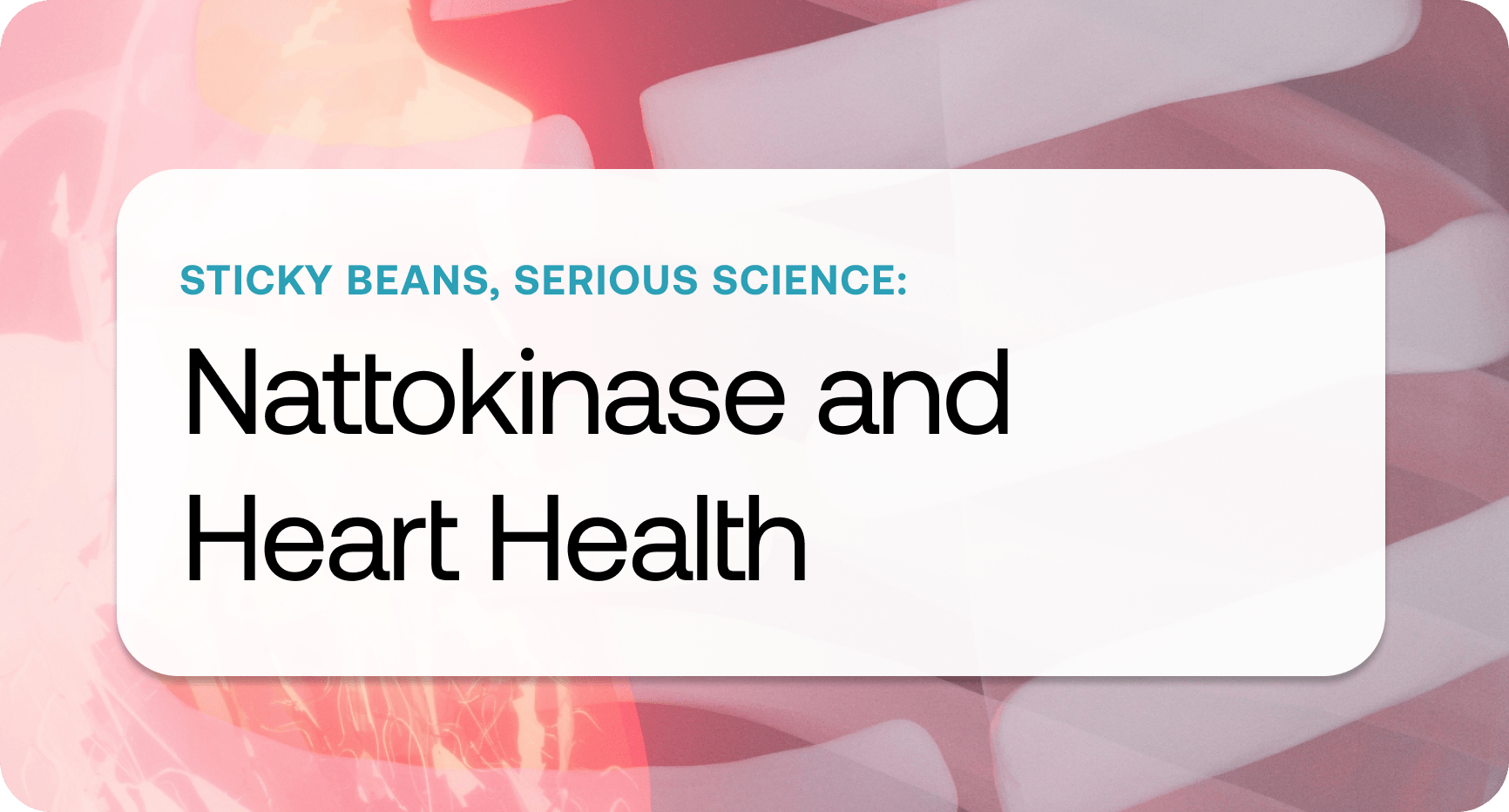Science Corner 16 | Sticky Beans, Serious Science: Nattokinase and Heart Health

Fish oil, CoQ10, magnesium, garlic. The list of supplements commonly linked to cardiovascular health is familiar and fairly well-trodden. But every so often, an under-the-radar ingredient begins to gain momentum based on intriguing, if early, evidence.
One such compound is nattokinase, an enzyme isolated from natto, a traditional Japanese fermented soybean dish known for its strong flavor, sticky texture, and devoted following. Nattokinase is quickly gaining attention as a promising supplement for cardiovascular health, and it is likely to become much more familiar in the years ahead.
What sets nattokinase apart is its unique mechanism.
Unlike other heart-healthy compounds that target cholesterol, inflammation, or oxidative stress, nattokinase works directly on fibrin, the protein backbone of blood clots. By breaking fibrin down, nattokinase may support healthy blood flow and help maintain optimal clotting balance, a function more commonly associated with prescription anticoagulants.
But does nattokinase really work? Let’s look at the science.
A Pivotal Study on Nattokinase and Atherosclerosis
In 2022, researchers published a large, year-long clinical trial evaluating the effects of nattokinase on atherosclerosis and lipid profiles in over 1,000 participants. It is one of the most comprehensive studies on nattokinase to date.
Participants were randomized to take a high dose of 10,800 FU/day of nattokinase. Although it is not standardized globally, the fibrinolytic units (FU) serves as the best approximation for dose.
At the end of 12 months, the high-dose group showed:
22% reduction in artery wall thickness, a structural marker of atherosclerosis
37% reduction in carotid plaque size, suggesting regression of existing arterial plaque
16% drop in total cholesterol, 18% reduction in LDL, and 16% lower triglycerides
A 16% increase in HDL cholesterol
Importantly, no major adverse effects were reported, and compliance over the 12-month period was high.
These findings suggest that nattokinase may support cardiovascular health through multiple mechanisms: improving blood flow, reducing lipid levels, and potentially regressing arterial plaque. That combination is rare in the supplement world, where most ingredients work through a single, narrow mechanism.
Why This Matters
Cardiovascular disease remains the leading cause of death worldwide. While lifestyle changes, medications, and established supplements play important roles, many people seek additional, natural ways to support heart and vascular health.
Nattokinase represents a novel intervention, targeting fibrin accumulation and microvascular flow in ways that traditional agents do not. Its potential to reduce carotid plaque, lower cholesterol, and improve arterial structure is both exciting and unusual.
That said, some notes of caution are warranted:
The high dose (10,800 FU/day) used in the study is three times higher than most commercially available supplements, which typically offer 2,000-4,000 FU/day.
FU is not a globally standardized measure, so actual enzyme activity may vary widely between brands.
Nattokinase has a pharmacological effect, especially at higher doses. It may interact with anticoagulants or antiplatelet medications, and should not be used casually alongside prescription blood thinners.
As with any promising new intervention, more research is needed. The study above was not placebo-controlled, and further randomized trials will be needed to confirm and replicate its results.
There is also a pharmacological side to consider. Because nattokinase has measurable activity in the blood, it should not be mixed casually with prescription anticoagulants or antiplatelet drugs. It is not an inherently dangerous supplement, but it may not be suitable for everyone, especially those on prescription medications for heart health.
Still, nattokinase has the feel of a compound at the beginning of its story rather than the end. Its origin in a fermented food with a long history of use adds credibility. Its novel mechanism sets it apart from better-known options. And its early trial data, while not yet definitive, are intriguing enough to merit attention.
If you are exploring ways to support cardiovascular health and have not yet encountered nattokinase, this may be one to keep an eye on. The science is still developing, but the enzyme behind Japan’s stickiest soybean snack might just be one of the more interesting heart health discoveries in years.
--
Personal note from Jordan
A few weeks ago, a close colleague asked me what I thought about nattokinase. At the time, I only had a vague sense of what it was... something to do with natto, possibly beneficial for circulation. That question stuck with me, and like many things in the supplement world, it turned into a welcome deep dive. The more I read, the more I realized how much I still had to learn.
What makes nattokinase especially compelling to me is not just its mechanism, but its origin. I spent quite a bit of time working in Japan years ago, and natto was a common part of my meals. Back then, I did not think of it as a functional food, just a local staple with a strong smell and sticky texture. Now I see it differently.
The supplement space is global by nature, scientific discovery, traditional practices, and modern formulations all blend across borders. Whether it is soybeans fermented in Japan or botanicals harvested in South America, every culture contributes something to the broader picture of health. Our job is to keep exploring, keep learning, and stay open to where the next question might lead.
